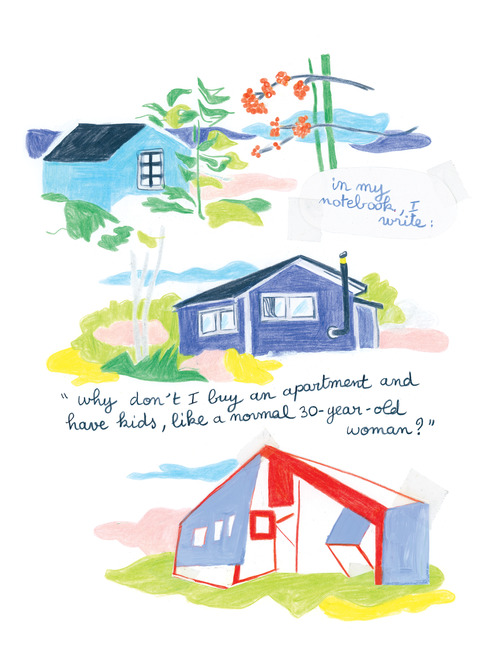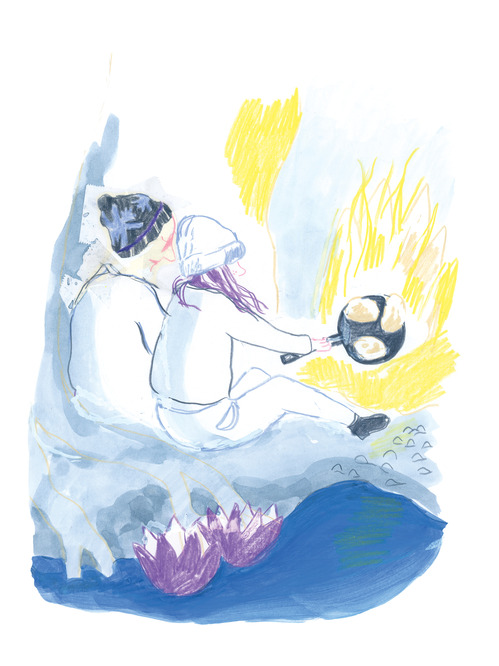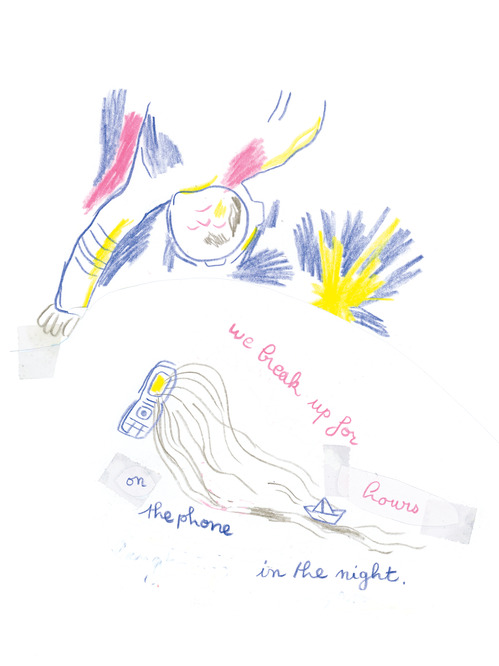Julie Delporte on Process, Tove Jansson & This Woman’s Work
Art by Julie Delporte Comics Features Julie Delporte
Julie Delporte’s drawings feel painstaking, but not because they’re incredibly neat or full of tiny stipples. She works in soft, bright colored pencil, composing more by page than by panel, and each line she sets down feels earned, deliberate, intentional. The meticulous but not dispassionate process of translation is probably the best metaphor for the way her comics work. It’s as though by drawing something, she’s trying to make it exist anew, translating it from the real world into two dimensions. She’s always synthesizing different materials (film, literature, comics, experience, big thoughts about the world, anger at a history of being dominated) into a picture rich with feelings that leaves room for further interpretation. This Woman’s Work, her new book, is out from Drawn + Quarterly March 5th, and she answered questions over email about her process, her influences and why she loves Tove Jansson.
![]()

This Woman’s Work Cover Art by Julie Delporte
Paste: Your books are not very long, but they feel like they should be read slowly and like they are made slowly. Is that accurate?
Julie Delporte: It took me four years to write and draw This Woman’s Work. I am not very adapted to productivity. It’s not that I don’t care—I think of it every day. I was shaped to. But I just can’t keep up the pace. And I am grateful I can’t. A lot of people told me after finishing This Woman’s Work that they immediately felt the need to reread it more carefully. I think if the ideas I bring into the book are new to you, you may need time to process them.
Comics traditionally come from popular culture, and sometimes they can be very straightforward, but I come from literary studies, and I am more used to not explaining everything, to let the readers think it through… It echoes with the sentence from Chantal Akerman that I quote in the book: “I want people to feel the passage of time in their bodies. That way I won’t have robbed them of two hours, they’ll have lived them.” I don’t want to impose anything on anyone. Also, explaining feminism is exhausting (I like when Hannah Gadsby says “I identify as tired”), and I feel very limited. I do the part I can do and hope people will slowly do their work too…
Paste: When did you start using colored pencils? What feels right about that medium to you?
Delporte: I started to use them at the beginning of my career, I felt that it was the only medium I would be able to have a very personal style with, a style which does not seem to be anyone else drawing. I had read so many comics before I started drawing them that I was really aware of who used which style of lines. We are all influenced by the drawing styles of other artists. Sometimes it’s just in the air; it’s not even coming directly from reading someone in particular… I am not very dogmatic about things, but if I had to write a manifesto for fun about drawing, there would be something about being aware of who draws and drew like you.
I think what felt right about colored pencils are the way they mix both the non-inked result and the colors. Most of the time, I drew very sad things, so hopefully there is color, or it would be too emo. Life is like that, full of good and bad things, dark and light at the same time.
Paste: I read that you’re a big fan of cartoonist Dominique Goblet. When did you first encounter her work and what does it mean to you?
Delporte: I knew her work from reading her books published in French by Frmk and L’association, a long time ago. It is only recently that one of her books has been translated into English. You mention her because Wikipedia quotes my interest in her work, but she was not my only drawing influence, far from that. I loved people like Joanna Hellgren and Amanda Vahamaki when I started to draw, and I surely came from that wave of European pencillers.
I love Dominique Goblet because she is between comics and visual art. She also published painting books. One of the books is portraits of her daughter and her that they did of each other for 10 years. It’s a truly autobiographical work for me. You can see her daughter growing through the portraits made by her mother, and the mother stays the same in the images, but you can see the childish drawing of the daughter changing. I love when comics are not just comics…
In terms of content, I was more influenced by Joanna Hellgren’s stories of lesbian couples or Amanda Vahamaki’s dreamy narrations. A book by Jean-Christophe Menu (the former publisher of L’association), Livret de Phamille, made a big impression on me. It was where I discovered you could just write and draw about your readings and daily thoughts and life. You could be an intellectual and make comics. I also liked a lot the work of David Libens. He did zines called How Are You Doing. When you’d ask him this question out of politeness, he would give you the zine as an answer, and inside there was a description of how he was really doing.

This Woman’s Work Interior Art by Julie Delporte
Paste: Like Goblet, you like to make your process more transparent by showing things like tape. Did you learn that from her work? Why do you do it?
Delporte: Her work may have given me the permission to do that. I first used it because I wasn’t able to draw directly what I liked, and colored pencils could not be erased. So I would cut and paste a piece of paper on top to correct my drawings. I like the idea of giving to the reader something close to the reality of my drawings, something that makes them feel they are reading a real journal they could have found in a flea market or sneaked in secretly, whether it’s a fiction of my own journal. I want to give to comics a sense of reality, otherwise it’s a medium too coded for me, too close from cinema. This is why I am not so interested in the idea of sequence or movement.
Paste: Did you go to art school?
Delporte: No! There are no artists at all in my family, not even in my distant family. I had no model for being an artist and could not get around the tradition of ensuring an economic comfort for my future. So I studied journalism, the closest I could find to writing. I hated being a journalist. I just wanted to write literature and make documentaries. I hated the lack of distance of news.
After I immigrated from France to Quebec, I was able to detach more from my family’s capitalist background, and Montreal is a place where I found the social and economic possibility to become an artist. For a long time I regretted not studying in art, but I did read so much about art, I think it’s okay. It’s probably even better in the end. Art school would have given me even more dogmatic thoughts to get rid of after. And later I did a master’s degree in cinema studies, which gave me a lot of the theoretical knowledge I was craving for.
Paste: Your work feels very much in a European tradition, not a Canadian one, down to your very French handwriting. What influences do you think have shaped your artistic practice?
Delporte: Oh, I think I already answered this about my graphic novel influences from Europe… But I do have a lot of European writers that influenced me, too. The work of the French writer Annie Ernaux, which is not so known in English, was really important to me. The way her writing is both very personal and social, the way her writing is so precise but also so simple and accessible, and the way all her different books talk to each other, leading to a coherent big work.

This Woman’s Work Interior Art by Julie Delporte
Paste: This Woman’s Work is structured as a diary. Was it really one? Do you keep diary comics?
Delporte: I keep a diary that is not a comics one. I write a lot in sketchbooks. This Woman’s Work comes from these diaries, but the timeline has been shaken. I think it reflects the process of trauma and of mourning. These are not straightforward narrations but non-linear ones. Feelings go back and forth, the forgotten past is living in the present, etc. Sometimes you think you’re over something, but later you realize you’re definitely not!
Paste: When you started making this book, it seems like it was supposed to be about Tove Jansson. What made you change the focus to something more general, using Jansson as more of a jumping-off point?
Delporte: I first wanted to make a nonfiction book about Tove Jansson, because I loved the Moomins (the characters of the stories she became famous for) and I felt she was a good subject, that people would love to read about her. So I went to Finland, where Tove is from, to do research about her life. Then I changed my mind, and tried to make a fiction about her, where an anthropologist would investigate on the existence of Moomins. Some pages from this fiction project remained in the final book, when I say I search for Moomins in the forest and that I found a campfire by the water made by Snufkin. If I was a full-time artist at the time, maybe one of these projects would have become a book. But it took me four years to write This Woman’s Work, and at some point I realized why I was so fascinated by Tove Jansson. I was desperately lacking feminine role models that related to me.
She was the first woman in comics history whose work and life I loved. When I read her biographies, I fell in love with her character and her life choices. Her connection to wilderness, the fact she had a range of different artistic practices (painting, writing novels, drawing comics)… I wanted to be like her! It was the first time it happened for me, wanting to be like another woman. Before, I had only identified with men. I found a Christian Rosset quote (a French comics critic): “You have to fail at making the book you had in mind, so that you can end up with a good book that neither the author or the reader was expecting.” So I failed at making my book on Tove Jansson, which anyway would have been too straightforward, almost too commercial for me. It became something better, between a political essay, a personal journal and poetry. Eventually, it’s a book that says: “here is how I became a feminist, and here’s why this is the best thing that ever happened to me.”
Paste: How do you think your work in ceramics relates to your drawings? Do they influence each other?
Delporte: Ceramics is not my main art, it’s not profitable at all for me. I can’t make money from it, even if I sell a few pieces it’s never enough to match the long time I spend on them. I use a special etching technique (it’s called mishima) that is the way I found to make my drawings on ceramic look close to my drawing on paper. So that I can start to integrate my pieces into exhibitions… But it’s hard to be a multidisciplinary artist. You’re always put into a category; the graphic novel one is mine. I write essays in a lot of magazines too, but people always categorize me into comics. Maybe this is how humans are used to thinking, in little boxes: you’re a man or a woman, a human or an animal, you’re sane or insane… Your body and mind are separated. I’d like to reassociate all this. In comics we have this great uncomfortable place where we are both into words and images. Being able to express an idea using both is really something complete, something that encompasses my intuition and my rational side.

This Woman’s Work Interior Art by Julie Delporte

